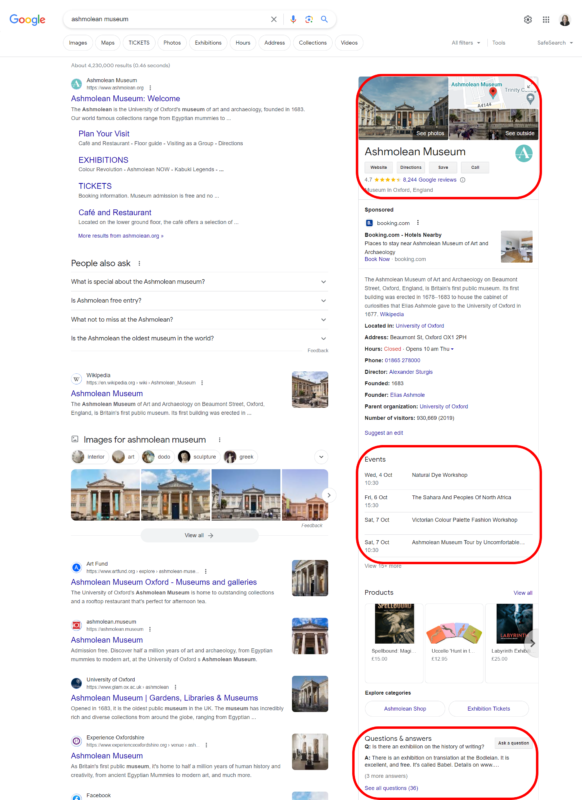Knowledge graphs are there to help users analyse and understand complex relationships between data points. A knowledge graph is a data cluster that can be used to inform business decisions based on facts.
Although data graphs contain intricate information, having an understanding of how they work will provide more straightforward, concise information than, say, pie charts, graphs and ladder illustrations to drive decision-making. Using a combination of nodes and edges, a knowledge graph uses nodes as a point to depict an entity or its type—entities such as organisations, objects, places or individuals. Any connection or relationship between two nodes in the graph is represented by an edge.
Ontology and Knowledge Graphs
You can’t fully get to grips with knowledge graphs without coming across the term “ontology”. Within the knowledge graph world, an ontology is a subset that formally lists entity types, interconnected relationships and the limitations in combining these entities and their relationships by laying down the rules that govern these relationships. A knowledge graph is a changing database that offers dynamic insights to users, with a format that can be extended and revised when new data arrives.
A knowledge graph is more relevant than a regular database. It stands alone to connect entities, removing the need to program new data as it arises manually.
Knowledge Graphs and SEO
Knowledge graphs are likely to be familiar to anyone involved in SEO – even if they don’t realise it! Anyone using a search engine will come across data from knowledge graphs within the search results they see. That data will usually be displayed in a Knowledge Panel on the right-hand side of the search results on a desktop or laptop screen.

The most relevant and popular information for any search topic is summarised within a knowledge panel obtained from facts and information shared across the web, and from open source and licensed databases. The Google Knowledge Graph contains over 500 billion facts!
The actual data shown can vary significantly from topic to topic but can include information such as:
- Title and short summary of the topic
- A longer description of the subject
- A picture or pictures of the person, place or thing
- Key facts, such as when a notable figure was born or where something is located
- Links to social profiles and official websites
The requirement to feature on search engines is driven by the change in what users expect from the internet. A search engine is now becoming a ‘full answer’ engine and provides a more structured result containing information about people, events, places and other concepts drawn from a knowledge graph. Knowledge graphs are valuable beyond the data science community, and their use has driven many applications, including virtual assistances Alexa and Siri, through their ability to combine knowledge bases and data integration.
How search engines understand our language matters
Search engines must be able to combine the words we use to create relevant results. If it could only search based on individual words, it could not provide results that answered our questions fully. For example, a knowledge graph will break down human language such that a machine can combine entities within searches to produce results related to multiple words within the search terms. This ability to use the entity concept can be seen in a simple search relating to an item and a place. Rather than results showing the item and separate answers relating to the place, the presence of a knowledge graph will enable linked answers such that search results are based on the item within the place to provide a more relevant answer for the user.
Why entities are relevant to SEO
With Google and other search engines seeking to become answer engines, the concept of entities within knowledge graphs is becoming more relevant. Entities help understand why and how search results are as they are.
Google aims to provide the most relevant and important information directly within the search results, so the user isn’t required to click further onto a specific website unless they need more specific information. The results will include relevant knowledge graphs that relate to the search intention, which means you may need to work harder to gain the website clicks essential to get your business noticed.
As a brand, you will want to build your brand identity. Creating an entity for your brand will help your chances of becoming the knowledge graph that makes it to the top of the search results. As a brand owner or individual, you can claim your own knowledge panel with the ability to edit the information it contains. To achieve a separate knowledge panel in search results, you must meet Google’s social relevance perspective. You will need an effective content strategy to create content and publish pieces that build and underpin your authority within the sector. A strong brand and SEO use is vital to making this happen.
Knowledge Panel Verification
Similar to that required by Google My Business, a knowledge panel must be verified via methods such as a linked social media account or via Google Search console. Knowledge graphs show when the information they contain is relevant, so it’s possible that how and when they display changes. Your knowledge graph may have more relevance when it contains specific information or at particular times, so it is a moving target to maintain.
Our basic guide to SEO and how to make it relevant will give you some dos and don’ts to help you get your content featured as part of the knowledge graph-driven, answer-driven search engines of today. However, the heart of search engines remains the same. What has changed is what it takes to make it work. You must now be seen as a brand and content creator that answers questions directly relevant to how the user searches and what they want to see.
Here at Ditto Digital, our team are well versed in how knowledge graphs can underpin your search engine results and how their interaction with quality content and effective digital marketing uses SEO to drive better results for businesses, so if all of this still seems a little confusing, or you don’t have the time or resources then we are here to help.




